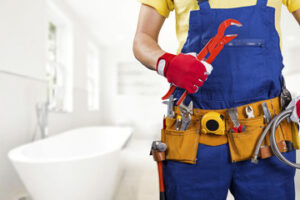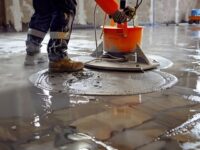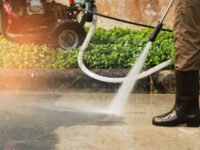Understanding How Plumbing Works
Plumbing brings fresh water into a facility and safely drains waste away. It is also used to heat and cool a building.
Plumbing relies on a variety of materials to function properly. From copper, renowned for its durability, to plastic PVC pipes, preferred for drain lines and vent stacks. Visit https://www.plumbing-express.com/ to learn more.
The plumbing system brings fresh water into a home or business and safely removes wastewater. This essential service is managed by a complex network of pipes, valves, and fixtures. The system may seem intimidating to the uninitiated, but understanding how it works reveals the ingenuity and durability of this crucial technology.
Your water supply arrives from a municipal water source or private well via a main line that connects to a service lateral, usually located underground. From there, the supply line slopes downward to a water meter and a shut-off valve that allows you to cut off your entire house’s water supply in emergency situations.
Water is then distributed to a series of faucets, showerheads, toilets, appliances, and fixtures throughout your home or business. Each fixture draws water from a specific supply pipe, which connects to the main supply line or a water heater in the case of hot-water supplies. Each of these pipes is a potential point of failure, subject to corrosion, damage, or other problems. The quality and integrity of your water supply depends on the condition of these pipes, so it’s important to hire professional plumbers for any repairs or replacements.
Most residential and commercial plumbing systems are made of copper, PEX, or PVC. PEX is especially popular for distributing water because it’s flexible, durable, and comes in long rolls that can be easily manipulated around corners. These lines can also be connected using push-fit fittings or crimp rings secured with a special tool, which reduces labor costs and improves installation time.
The water supply line is normally protected from freezing by being installed below the frost line. However, if it’s not properly insulated in cold climates, the pipes may freeze and burst. Water supply lines are also susceptible to slow, undetected leaks that can cause damage over time.
Wastewater from your sinks, showers, and toilets flows through drain pipes to the sewer system or septic tank. The wastewater is treated to remove contaminants, then returned to the environment. If these pipes aren’t properly sized or installed, they can lead to backups that can cause health and safety concerns. A professional plumber can evaluate your drainage system to ensure that it’s up to code.
Drainage
Drainage is more than just a convenience; it prevents damage and maintains the stability of land, structures, and buildings. It also helps with crop yields and soil quality. Understanding how drainage systems work is a must for anyone who wants to build a home or business.
The plumbing system of a home or commercial building consists of pipes, fixtures, and appliances that deliver fresh water and remove wastewater. It also includes the distribution systems that connect them to the public sewage and stormwater infrastructure. Plumbing works include installation, repair, and maintenance to ensure proper functioning of these systems.
Plumbing follows the basic laws of gravity and pressure, which are essential for supplying clean water and removing wastes. It also takes advantage of the properties of different materials to create an efficient, durable, and cost-effective system. It uses a wide variety of materials, from traditional metals like copper to modern plastics such as PEX and PVC. While it is important to understand the different plumbing technologies, a good plumber should know how to apply these principles to any situation.
There are many ways to keep your plumbing system in good working order, but prevention is the best strategy. It starts with preventing clogs by keeping drains clean and free of debris. Then you can avoid the expensive repairs and inconvenience of having to deal with standing water.
In addition, it is important to protect your sewer line from tree roots. This is because damaged or misaligned sewer lines can clog and overflow, which can lead to costly repairs. The best way to do this is to maintain a healthy root zone and avoid planting trees near your sewer line.
The drainage system of a building is as important as the water supply system. It diverts excess water away from the foundation, preventing erosion and structural damage. It also minimizes hydrostatic pressure on the foundation, reducing the risk of leaks. It is a good idea to talk to a plumbing expert about the drainage needs of your property, as they can offer insights that are specific to your geography and drainage needs.
Ventilation
Ventilation is the process of providing ‘clean’ air (normally outside air) into a space and removing stale air. This is achieved by opening windows and doors, and by using fans. The ventilation system in a home or business is critical to ensure good indoor air quality (IAQ). Good ventilation helps to dilute and remove metabolic pollutants (carbon dioxide and odour) and it also aids in the cooling of spaces.
If the ventilation system becomes clogged, sewer gases may seep into rooms through drainpipes, creating unpleasant and unhealthy conditions. Regular maintenance of the plumbing system can prevent ventilation problems from occurring. Other common plumbing problems include: dripping taps (worn washers or O-rings), running toilets (faulty flapper valve or fill valve), and slow draining pipes (hair, soap scum, grease, food particles). Regular maintenance can help to prevent these issues.
Heating
In some areas, plumbing systems include heating elements to supply hot water for fixtures and appliances. These systems can use electricity, natural gas, solar power or another energy source to heat water. They may also include controls and sensors to manage operation and safety. Insulation may be applied to pipes to reduce the rate at which heat escapes, saving energy and reducing utility bills.
Your plumbing system is an essential part of your home, but it’s often out of sight and mind until something goes wrong. Knowing a little bit about how plumbing systems work can help you spot problems early and save yourself the cost of costly repairs. Plumbing is a complex network of pipes, fixtures and fittings that carry water and sewage throughout your home or business. It follows basic laws of gravity and pressure and abides by local regulations and standards. A well-maintained plumbing system is crucial to your daily life, but it needs regular care and attention to function properly.






